
August / September 2003, Issue 25
EQUIPMENT REVIEW
Alón Lotus Elite Loudspeaker
by Roy Gregory
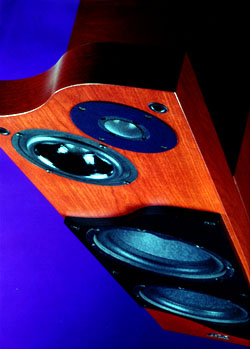 Some products just seem right, right from the first moment you see
them. Okay so Scot Markwell had been on my case about the
Alóns, virtually dragging me into their room at CES, but from
that first look (and listen) it was obvious what he was so excited
about. The sound in the room was superb, running on the end of a
system based on the one used by HP to drive the monster Alón
flagships at Sea Cliff, and put together by the aforementioned
Mr. Markwell. But there was more to it than that. Importing speakers
to the UK is a thankless task at the best of times. You just have to
look at the history, Sure, Apogee and Magneplanar speakers enjoyed a
brief period in the sun, helped by a passing fashion for panel designs
which the native manufacturers seemed incapable of satisfying. Since
then, only the very pretty Martin Logans and the critically acclaimed
Wilsons have achieved anything like their sales potential in this most
difficult of markets. Even the spectacularly good Spica TCSO failed to
achieve anything like the presence it deserved. One of a long list of
failed contenders, Alón's challenge was always marred by an
overgenerous bottom-end, well suited to US dry-wall construction, but
less so to the smaller and more solid rooms found this side of the
Atlantic.
Some products just seem right, right from the first moment you see
them. Okay so Scot Markwell had been on my case about the
Alóns, virtually dragging me into their room at CES, but from
that first look (and listen) it was obvious what he was so excited
about. The sound in the room was superb, running on the end of a
system based on the one used by HP to drive the monster Alón
flagships at Sea Cliff, and put together by the aforementioned
Mr. Markwell. But there was more to it than that. Importing speakers
to the UK is a thankless task at the best of times. You just have to
look at the history, Sure, Apogee and Magneplanar speakers enjoyed a
brief period in the sun, helped by a passing fashion for panel designs
which the native manufacturers seemed incapable of satisfying. Since
then, only the very pretty Martin Logans and the critically acclaimed
Wilsons have achieved anything like their sales potential in this most
difficult of markets. Even the spectacularly good Spica TCSO failed to
achieve anything like the presence it deserved. One of a long list of
failed contenders, Alón's challenge was always marred by an
overgenerous bottom-end, well suited to US dry-wall construction, but
less so to the smaller and more solid rooms found this side of the
Atlantic.Not so the Lotus Elite. What I was seeing was a speaker of almost European dimensions, its twin bass drivers contained in a compact, infinite-baffle, floor-standing enclosure topped with an open-baffle carrying mid-range and high-frequency drivers. What I was hearing was wide bandwidth sound with a smooth, smooth balance, a huge sound-stage and really impressive dynamics. Sure, designer Carl Marchisotto had added a pair of his new sub-woofers to the system but even so...
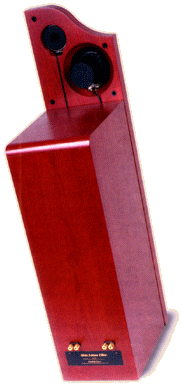 Now, five months later, I'm looking at (and listening to) the same
speakers sat in my front room, and you know what, I wasn't wrong about
them the first time round. Which could make this the shortest review
on record: they're great and I told you so! What - you mean you want
more detail? Oh, okay if I must...
Now, five months later, I'm looking at (and listening to) the same
speakers sat in my front room, and you know what, I wasn't wrong about
them the first time round. Which could make this the shortest review
on record: they're great and I told you so! What - you mean you want
more detail? Oh, okay if I must...
I'm guessing here that Marchisotto has an unwise regard for vintage English sports cars (there's an Esprit in the range too) and that he should therefore know that his chosen moniker suggests performance at the expense of reliability and bits dropping off! Such are the vagaries of modern international marketing. The Alón Lotus Elite is available in two different but outwardly similar versions, standard and Signature. It's the standard model that we have for review. Outwardly it's a fairly straightforward three-way design. Under the skin, it has more than its fair share of wrinkles.
The two pulp-coned 8" bass units each enjoy their own, separate chamber, and each chamber is a different size. According to Alón, this arrangement improves bass linearity transient response and transparency. It's a claim that you have to take seriously given the speaker's performance. The drivers are mounted on a substantial 40mm baffle, and surrounded by a cosmetic trim that helps prevent consistent diffraction from their chassis surrounds. It also mimics the French curve used on the mirror-imaged baffle tops to soften what would otherwise be a rather slab-like appearance. The baffle extension supports a 130mm plastic coned (described as tri-laminate) midrange driver and a 25mm aluminium dome tweeter. Both drivers are mounted open baffle and deliver dipole output. They are offset at 45 degrees to each other, Alón's preferred disposition and one that they suggest gives more realistically scaled images than the more traditional vertical array The speakers are set-up with the mid-range units outermost. The mid-range driver sports a large cosmetic cover over its motor assembly the size dictated by the use of weak but extremely linear AlNiCo magnets. The Signature version uses AlNiCo for all its drivers, along with external crossovers. The crossover on the review sample is internal, but the boards are physically separated for the two bi-wirable legs. Back to the midrange driver, the smooth motor housing combined with the careful sculpting of the baffle's rear where it surrounds the driver should minimize turbulence in the rear output. The hard voice coil cover in the cone's centre is pierced by a small hole, though whether this is for venting or resonance dispersion reasons it's impossible to tell. The open rear of the tweeter is covered by a foam disc in order to prevent contamination by dust or other foreign bodies. Grilles are also provided for both the speaker's front and the rear of the flying baffle, although I preferred the appearance without them in place (as well as the sound).
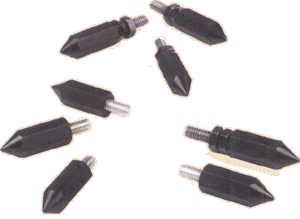 Spikes are provided for the speakers, but they are much blunter than
the UK norm. They won't pierce carpets although they do provide an
otherwise stable footing. The front ones have a couple of thin nuts
added to their tops so that the speaker tilts back very slightly with
the feet installed. Experimentation suggests that this is more to do
with the tweeter axis and the relatively low height at which it's
placed than any attempt to time align the drivers. Set-up is pretty
standard as regards positioning and general care, with but one
proviso. The low-frequency extension of the speaker makes distance to
the rear wall critical. In my room, two feet of clear space was
spot-on, but even an inch nearer and the bass became slow and leaden,
but more importantly the mid-band muddied and the stage
collapsed. Dull and sluggish, the resulting sound will have you
wondering just what that idiot reviewer was getting so excited
about. But get the bass to mid balance right and the dynamics blossom
along with the space and immediacy of the soundstage.
Spikes are provided for the speakers, but they are much blunter than
the UK norm. They won't pierce carpets although they do provide an
otherwise stable footing. The front ones have a couple of thin nuts
added to their tops so that the speaker tilts back very slightly with
the feet installed. Experimentation suggests that this is more to do
with the tweeter axis and the relatively low height at which it's
placed than any attempt to time align the drivers. Set-up is pretty
standard as regards positioning and general care, with but one
proviso. The low-frequency extension of the speaker makes distance to
the rear wall critical. In my room, two feet of clear space was
spot-on, but even an inch nearer and the bass became slow and leaden,
but more importantly the mid-band muddied and the stage
collapsed. Dull and sluggish, the resulting sound will have you
wondering just what that idiot reviewer was getting so excited
about. But get the bass to mid balance right and the dynamics blossom
along with the space and immediacy of the soundstage.
I don't have an efficiency figure for these speakers, but they're a moderate load and the manufacturer quotes a minimum amplifier requirement of ten Watts per channel. The Border Patrol P20 certainly had no trouble kicking them into life, although they did suffered a tendency to close in at lower volumes, there being a definite threshold at which they sprang to life. I'd feel happier with a sensible minimum of 20 or so high-quality Watts. Even with the 125 Watt Hovland Radia, the effect was still there, albeit far less noticeable: more a shrinking and retreating of the stage than a clogging or close down. Playing 'True Love Ways' (Buddy Holly Legend MCA MCMD 7003) start at a low level and the stage is all there, complete with boundaries, the distinct back wall, the control-room speaker high to the left. The players are where they should be, the detail and proportions of the instruments correct. But start to advance the volume control a notch at a time and the stage will swell, Buddy will step forward and straighten up, the music gains immediacy and life as the micro-dynamics become more explicit. If you have to listen at low volumes or use a low-powered SET amp then you'll need to check this out. If you listen at more normal levels then you'll have no problems, but either way you should hear these speakers, because what they do is really quite special.
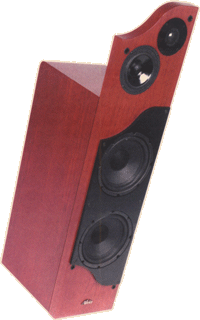 Check out the dimensions and you'll see that the Lotus Elites are far
from large. They have a manageable footprint and whilst they require
space behind them, they manage to remain surprisingly discrete,
especially given the nature of the sound they produce. The
Alóns pull two tricks that are unusual in a speaker at this
size and price. By now you know that they go low in the bass (around
the 35Hz mark, with another 6Hz from the Signature) but all too often
that's a mixed blessing. Not in this case: The Elite's low frequencies
are long on both extension and quality but the really impressive thing
is how they integrate seamlessly into the mid and treble. The evenness
of the energy spectrum from this speaker is remarkable, as is its
sense of tonal integrity. Provoke the tweeter and you can
occasionally generate a hint of glaze and metallic smear but you've
got to try pretty hard and use some fairly underhand
recordings. Otherwise, despite the disparate diaphragm materials
involved, the tonality of singers and instruments is unusually
consistent, an underestimated benefit that has a huge effect on the
believability of what you hear. But the second (related) benefit is
the real kicker that sets these speakers apart: They are astonishingly
(refreshingly) free of box effects.
Check out the dimensions and you'll see that the Lotus Elites are far
from large. They have a manageable footprint and whilst they require
space behind them, they manage to remain surprisingly discrete,
especially given the nature of the sound they produce. The
Alóns pull two tricks that are unusual in a speaker at this
size and price. By now you know that they go low in the bass (around
the 35Hz mark, with another 6Hz from the Signature) but all too often
that's a mixed blessing. Not in this case: The Elite's low frequencies
are long on both extension and quality but the really impressive thing
is how they integrate seamlessly into the mid and treble. The evenness
of the energy spectrum from this speaker is remarkable, as is its
sense of tonal integrity. Provoke the tweeter and you can
occasionally generate a hint of glaze and metallic smear but you've
got to try pretty hard and use some fairly underhand
recordings. Otherwise, despite the disparate diaphragm materials
involved, the tonality of singers and instruments is unusually
consistent, an underestimated benefit that has a huge effect on the
believability of what you hear. But the second (related) benefit is
the real kicker that sets these speakers apart: They are astonishingly
(refreshingly) free of box effects.
Roll these two attributes together and you have the foundation of the Alóns' musical presentation and integrity. The combination of the wide bandwidth and the dipole mid and treble drivers produces a huge soundstage that extends well beyond and behind the speakers. In fact, the sheer scale of the presentation is reminiscent of my old Magnaplanars, as is the proportion and nature of the images. If you want the sort of pinpoint, etched imagery that comes from harmonically challenged mini monitors then you'll be disappointed. These offer a larger more dimensional and more realistically proportioned view of the original event, aided by the considerable depth generated by the speaker. The proportions and coherence of the soundstage will be effected by the nature and symmetry of the rear wall so if you want to get the best from the Alóns then that's another consideration. More importantly where the sound deviates from the more familiar dipole presentation is in the tighter and far more even bass response, devoid of the comb-filtered anomalies that afflict full-range dipole radiators. Plucked acoustic bass lines are especially tactile and satisfying, with excellent speed and attack, despite their weight and depth. And this is where the lack of box colourations comes in. Tonally of course, that's good news. It leaves instrumental character intact and voices easily recognisable. All good stuff, but along with the lack of extraneous colour the careful cabinetry (or lack of it) eliminates time-smear too, and that's what makes the difference. The expansive soundstage combined with the quick, tactile bass and agile, rhythmically explicit mid-range makes for music that breathes but has purpose, is relaxed yet engaging. There's no sense of the pace being forced or artificially propelled.
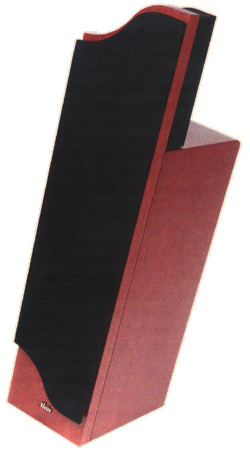 Instead, the music has its own sense of tempo, just as much drama as
required and dynamics on demand. It engages and entertains just as it
should, and all from a discrete and domestically acceptable
package. Praise be...
Instead, the music has its own sense of tempo, just as much drama as
required and dynamics on demand. It engages and entertains just as it
should, and all from a discrete and domestically acceptable
package. Praise be...
Complex music like Alison Krauss's 'Forget About It' offer a perfect example of the Elite's attributes. The different, interlocking rhythms are negotiated with ease, the sense and impetus they lend to the track keeps it moving without impinging on the delicacy and expressive breathiness of the vocals. The space and natural separation within the soundstage makes understanding the interlocking elements so much easier as well as appreciating the contribution and excellence of the individuals. The overall coherence ensures that the whole is artistically greater than the sum of the parts.
This is the key to the Alóns' appeal. They have a quality of effortless scale combined with an easy intimacy that manages to relax and yet engage the listener at the same time. They also have a musical honesty and innate sense of spatial, dynamic and temporal proportion that keeps things satisfying and unusually credible. Dynamic range may not be the widest but it's perfectly scaled. The soundstage is wide, but it is equally deep and tall. Most importantly there are no lumps or bumps in the energy spectrum to disturb the music's rhythmic patterns and distract the listener. It's this inner balance and sense of proportion that is rare at any price. For Carl Marchisotto to have achieved it in an imported model of this size and these modest dimensions makes the Lotus Elite something akin to the speaker holy grail: It's musical and accurate, it's a grower rather than knock your socks off impressive and it's even affordable. But take your time with the little Alóns and you'll find it's a worthwhile investment.
TECHNICAL SPECIFICATIONS
Type: Three-way loudspeaker with open baffle mid and treble drivers
Drive units:
25mm aluminium dome
130mm tri-laminate cone with AlNiCo magnet
2x 200mw pulp cone
Efficiency: 89 dB (estimated)
Bandwidth: -3dB at 35Hz
Impedance: 8 Ohms nominal, 4 Ohms minimum
Dimensions (WxHxD): 255 x 1030 x 380mm
Weight: 35kg
Finishes: Cherry or black ash
Price: £4400
UK Distributor:
Alón UK Ltd.
Tel. 0207 8841490
E-mail. pammusic@bushinternet.com
Manufacturer:
Alón by Acarian
Net. www.alonbyacarian.com